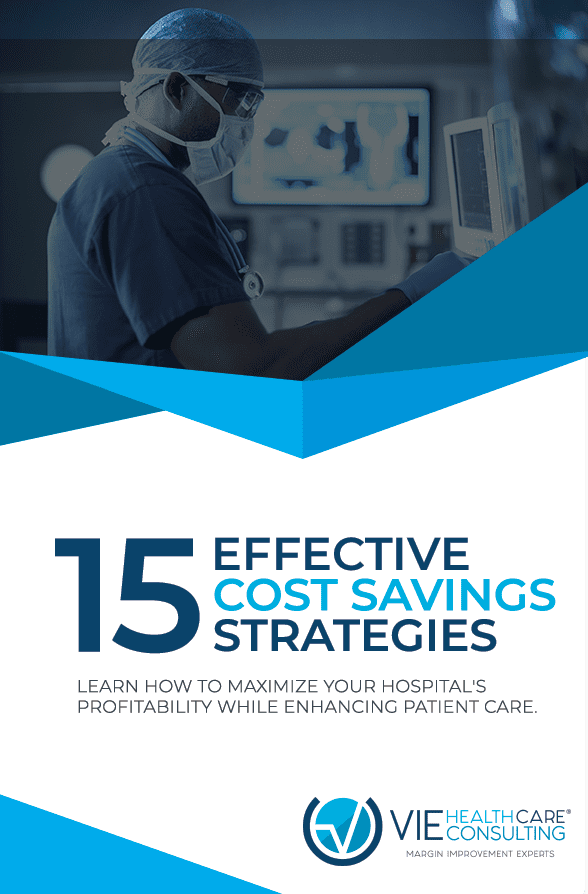Comprehensive Cost Awareness in the O.R.
This article was written by Lisa Miller.
Comprehensive cost awareness across a hospital requires an understanding of data and often vast amounts of information. To help to understand that information, we optimize cost management with Project CROS – Costs, Reimbursement, Outcomes and Social Determinants of Health.
In this blog, we consider how it relates specifically to the OR.
The OR accounts for up to 70% of a hospital’s revenue, between 55% to 65% of its margins and 50% of a hospital’s costs.
The OR accounts for up to 70% of a hospital’s revenue, between 55% to 65% of its margins and 50% of a hospital’s costs. This means there's an opportunity for cost savings. Read more here. Click To Tweet
Achieving cost reduction in the OR requires buy-in from the physicians, which in turn requires analysis and understanding of available cost data.
A 2017 study, Association Between Surgeon Scorecard Use and Operating Room Costs found that:
‘’….providing cost feedback to surgeons …..was associated with significantly reduced surgical supply costs, without negatively affecting patient outcomes’’.[1]
Presenting cost data to physicians was shown to reduce costs by 6.54%. In contrast, where that data was not made available, the costs increased by 7.42%, representing a 14% gap in cost management opportunities.
In summary, taking no action, by doing nothing, your costs increase.
It is something we see intuitively in our work at VIE Healthcare® and the solution is as logical as implementing a cost awareness program in the OR, in real-time to gain buy-in and feedback from your physicians.
A further study found that the majority of surgeons were unable to correctly estimate the costs of items and implants in their OR. This presents an opportunity to improve the ways in which cost data is provided to physicians and promote value based decision making[2].
In our work at VIE Healthcare®, we know from experience that when physicians can identify the costs of supply items in real-time, from a source they trust, they will make changes.

What matters is how the data is presented to them and how consistently. We recommend a minimum weekly basis. When surgeries are being performed regularly, a daily basis is also acceptable. The key is to ensure data integrity, which is achievable with spend analytics.
Project CROS: The four data points of spend analytics
Spend analytics is essential in hospital cost management and must always begin with a baseline and historical view of cost utilization and outcomes. From there, we move to ongoing monthly management and develop key performance indicators to analyze and automate costs. This analysis is carried out by department.
The emphasis is on consistency of information, which doesn’t necessarily mean multiple areas to begin with. It can be achieved with just three or five specific areas each month.
As part of our work, we infuse four different data points that make up what we describe as Project CROS. These are:
- Cost
- Reimbursement
- Outcomes
- Social Determinants of Health
We include Social Determinants of Health (SDOH) as part of the constant innovation and understanding of costs that all hospitals need in order to maximize cost savings and enhance patient care.
All of our work is grounded in line item detail.
Why begin with the OR?
The OR is important as it has the highest potential for revenue, but also the highest cost. Research shows that a high performing OR is also an indicator of a health system which offers[3]:
- Operational excellence.
- High fiscal performance.
- Quality care with best clinical outcomes.
- Greater patient satisfaction.
A specialized focus in the OR covers numerous aspects, from process improvement, clinical costs, governance, charge captures, staff optimization and patient satisfaction.
Keep in mind that most surgeons have never been presented any data analysis on OR supply costs. We help hospitals to gain insight into this kind of data so they can quickly identify missing items or incorrect charges.
CROS is incorporated across a single platform/dashboard. For the OR it offers the following benefits:
- A value based care optimization tool (especially for high cost case review, for example, orthopedic, spine and cardiac).
- A comprehensive approach to rapidly visualize patient information and standardize OR processes.
- Detailed assessments embedded when a drill down into the data is needed (quality, PROM, PT, Patient Satisfaction).
- The ability to compare and contrast product results for value-analysis.
- The ability to analyze and understand true costs. Reimbursement and outcomes will uncover hidden cost saving opportunities. Evidence based information is provided to support negotiations with vendors and contract reviews.
- This data provides comprehensive metrics to executive leadership and surgeons to support innovation and initiatives in this area.
Using clear, reliable data analysis, VIE Healthcare® identifies cost savings in the OR and provides proven solutions to achieve and preserve those savings.
For more information, download our Research Report Cost Reduction in the OR.
Schedule a call with Lisa Miller to discuss how Project CROS can help your health system reduce costs in your OR.
[1] https://jamanetwork.com/journals/jamasurgery/fullarticle/2589764
[2] https://insights.ovid.com/crossref/00000627-201605000-00002?isFromRelatedArticle=Y
[3] https://viehealthcare.com/cost-reduction-in-the-or/



